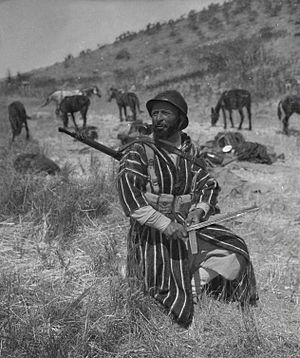Operation Diadem facts for kids
Quick facts for kids Operation Diadem |
|||||||
|---|---|---|---|---|---|---|---|
| Part of the Winter Line and the battle for Rome of the Italian Campaign, World War II | |||||||
 Allied plan for Operation Diadem |
|||||||
|
|||||||
| Belligerents | |||||||
|
|
|||||||
| Commanders and leaders | |||||||
| Units involved | |||||||
Operation Diadem was a major military plan during World War II. It was also known as the Fourth Battle of Monte Cassino or the Battle of the Liri Valley in Canada. This operation took place in May 1944 in Italy.
The Allied forces, including the U.S. Fifth Army and the British Eighth Army, launched this attack. Their goal was to break through the strong German defenses. The German forces they faced were part of the German 10th Army.
Contents
Why Operation Diadem Was Important
The main goal of Operation Diadem was to break through the German defenses. These defenses were part of the Winter Line, specifically the Gustav Line. The Allies wanted to open up the Liri Valley, which was the main path to Rome.
General Sir Harold Alexander was the Commander-in-Chief of the Allied Armies in Italy. He planned Operation Diadem to happen around the same time as the invasion of Normandy. This was to keep German soldiers busy in Italy. It stopped them from being sent to France to fight there.
The Allied Attack Plan
Four main groups of soldiers, called corps, were part of the attack.
- On the right side, there was the Polish II Corps.
- Next to them was the British XIII Corps.
- These two corps were part of the Eighth Army.
- On the left, there was the French Corps, which included Moroccan Goumiers.
- Next to them was the U.S. II Corps.
- These two corps were part of the Fifth Army.
- The Fifth Army also controlled the U.S. VI Corps at the Anzio beachhead. This beachhead was about 60 miles northwest.
Breaking Through the Defenses
Operation Diadem began at 11:00 PM on May 11, 1944.
- Parts of the British 4th Infantry Division and 8th Indian Infantry Division led the attack.
- They were supported by the 1st Canadian Armoured Brigade.
- They successfully crossed the Garigliano and Rapido rivers at night. This was very difficult because the Germans fought back hard.
- This breakthrough allowed the Allies to enter the heart of the German defenses in the Liri Valley.
- The French Corps pushed through the mountains on May 14. They were helped by the U.S. II Corps along the coast.
- On May 17, the Polish II Corps attacked Monte Cassino.
When the German defenses started to fall apart, they had to retreat. They moved back from the Gustav Line to the Hitler Line, which was about 10 miles behind them.
The Hitler Line and the Push to Rome
On May 23, the four Allied corps attacked the Hitler Line. On the same day, the U.S. VI Corps launched an attack from the Anzio beachhead.
The 1st Canadian Infantry Division broke through the Hitler Line. This happened at Pontecorvo on May 23. The German Tenth Army was then forced to retreat northwest.
The U.S. VI Corps was moving northeast from Anzio. They were close to cutting off the German escape route. However, Lieutenant General Mark W. Clark, who led the Fifth Army, ordered them to turn northwest and advance on Rome instead. Many people believe he did this so his Fifth Army would be the first to capture Rome. Because of this decision, the German Tenth Army was able to escape being surrounded.
The Germans tried to slow down the Allies with a series of smaller battles. They retreated to the Trasimene Line. After that, they moved to the Gothic Line, which was north of the Arno River.
Gustav Line Breakthrough
In his book about his life, General Mark W. Clark wrote about how the French Expeditionary Corps (FEC) managed to break through the strong Gustav Line in May 1944.
See also


